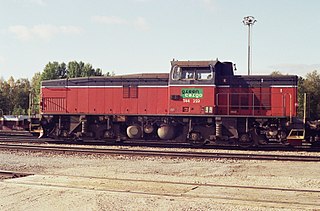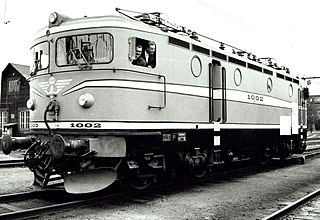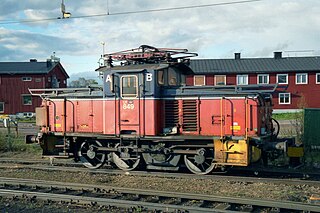
The Norwegian railway system comprises 4,109 km of 1,435 mm track of which 2,644 km is electrified and 274 km double track. There are 697 tunnels and 2,760 bridges.

Vygruppen, branded as Vy, formerly the Norwegian State Railways, is a government-owned railway company which operates most passenger train services and many bus services in Norway. The company is owned by the Norwegian Ministry of Transport. Its sub-brands include Vy Buss coach services, CargoNet freight trains and the Swedish train transport company Tågkompaniet. In 2009, NSB carried 52 million train passengers and 104 million bus passengers. On 24 April 2019, passenger train and bus services were rebranded as Vy.
Linx AB was a railway company which operated inter-Scandinavian passenger trains between 2001 and 2004. Established as a joint venture between the Norwegian State Railways (NSB) and the Swedish state-owned SJ, Linx operated the routes from Oslo, Norway, to Stockholm, Sweden, and from Oslo via Gothenburg, Sweden, to Copenhagen, Denmark. Services were provided up to ten times per day. However, slow speeds caused by curvy infrastructure in Norway, combined with competition from low-cost airlines, caused the company to lose money, and eventually grounded operations. The services were taken over by NSB and SJ. The main rolling stock were eleven X2 electric multiple units, although it used SJ Rc-hauled trains on the Gothenburg–Oslo service. The company was based in Gothenburg.

The Ofoten Line is a 43-kilometre (27 mi) railway line in Narvik Municipality, Norway. It runs from the Port of Narvik to Riksgränsen on the Norway–Sweden border, where the line continues as the Ore Line via Kiruna and Gällivare to Luleå. The Ofoten Line is single track, electrified at 15 kV 16.7 Hz AC and has seven stations. The line only connects to the rest of the Norwegian railway network via Sweden. The main traffic is up to 12 daily freight trains operated by Malmtrafik that haul iron ore from Sweden to Narvik. In addition, CargoNet operates container trains, branded as the Arctic Rail Express (ARE), and Vy Tåg operates passenger trains, including a night train to Stockholm.

NSB Class 69 is an electric multiple unit used by Norwegian State Railways for a variety of commuter trains on the Norwegian railway system, as well as a few medium distance and branch line trains. It is the most common type of trainset in Norway, although the newer NSB Class 72 has also been introduced. All the trains were built by Strømmen.
Östra Södermanlands Järnväg (Ö.Sl.J.), Eastern Södermanland Railway is a 600 mm narrow gauge railway in Mariefred, Sweden. Steam-hauled passenger traffic is provided all days of the week during the summer.

The Iron Ore Line is a 398-kilometre (247 mi) long railway line between Riksgränsen and Boden in Norrbotten County, Sweden, owned by Trafikverket. The line also contains two branches, from Kiruna to Svappavaara and from Gällivare to Koskullskulle. The term is often colloquially used to also include the Ofoten Line, from Riksgränsen to Narvik in Norway, and the northernmost part of the Main Line Through Upper Norrland from Boden to Luleå. The railway from Narvik to Luleå is 473 kilometres (294 mi) long.
Ofotbanen Drift AS, trading as Ofotbanen, was a Norwegian passenger and freight railway company. The company operated a fleet of six locomotives, three multiple units, 22 passenger and 48 freight cars. The sole service was the passenger train Unionsexpressen between Oslo and Stockholm; it had previously offered freight haulage on contract.

The Y1 is a diesel-hydraulic standard gauge railcar. It is in use in Croatia, Serbia, Kosovo, Sweden and Uruguay. The production of the railcars was begun in 1980 by Kalmar Verkstad and Fiat Ferroviaria for Sweden.

T44 is a Swedish diesel-electric locomotive built by Nydqvist & Holm (NOHAB) and Kalmar Verkstad (KVAB) in 123 units between 1968 and 1987. It was the successor of T43, and used both for hauling and shunting. It is the most common diesel locomotive in Sweden, with state-owned Green Cargo as the largest operator. Other operators include Israel Railways (one), Malmtrafik (two) and formerly Norwegian State Railways and Inlandsbanan AB.

NSB Class 62 is the first electric railcar operated by the Norwegian State Railways, between 1936 and 1970. Four units were built by Skabo and Norsk Elektrisk & Brown Boveri in 1931–35, with unit has been preserved by the Norwegian Railway Museum.
NSB Class 87 is a class of 25 diesel-hydraulic railcars built by Strømmens Værksted for the Norwegian State Railways. Seventeen a-series units were delivered in 1941 and equipped with 93-kilowatt (125 hp) Deutz prime mover. Eight b-series units were delivered in 1952 and equipped with 110-kilowatt (150 hp) Scania-Vabis prime movers. The trains weighed 15 and 15.5 tonnes and had a maximum speed of 75 and 80 kilometres per hour, respectively for the a and b-series. They were used on many branch lines until the 1960s, when the gradual electrification caused most lines instead to be served with Class 86. The a-series was scrapped in 1972 and 1973, while the b-series remained used between Ål and Hønefoss on the Bergen Line until 1975 and on the Flekkefjord Line until 1981.

Dm and Dm3 is a series of locomotives used by Swedish State Railways and later Malmtafik i Kiruna (MTAS) for pulling iron ore trains on the Iron Ore Line in Sweden and Ofoten Line in Norway. A total of 39 double-locomotives (Dm) were delivered between 1954 and 1971, built by ASEA. A further 19 center locomotives (Dm3) were later delivered. Norwegian State Railways also operated 12 similar locomotives, designated NSB El 12. The Dm is a articulated, freight-optimized version of the Da-locomotive.

Rb is an electric locomotive operated by Swedish State Railways. Six locomotives were built by ASEA, in three series designated Rb1, Rb2 or Rb3.

U is a class of 152 electric shunter locomotives operated by the Swedish State Railways and Trafikaktiebolaget Grängesberg–Oxelösunds Järnvägar (TGOJ) of Sweden, and the Norwegian State Railways (NSB), LKAB and Norsk Jernverk of Norway. They were built by ASEA, Nyqvist och Holm, Motala, ASJ Falun and Thune between 1926 and 1956. NSB gave the class the designation El 10.

X16 and X17 was a series of electric railcars operated by Statens Järnvägar (SJ) of Sweden. They were built by Svenska Järnvägsverkstäderna and ASEA in 1955-1956 and delivered as 30 units. They are the electrical counterpart of Y6 and Y7 railcars. The units were mostly in service in Svealand, and later around Gävle and in Värmland in the 1980s. The X17 differed in having four-a-breast seating, instead of five.

Engelsberg–Norbergs Järnväg, the Engelsberg–Norberg Railway, is a 1,435 mmstandard gauge railway between Ängelsberg and Kärrgruvan in the province of Västmanland in Sweden, now being used by the Engelsbergs Norberg Järnvägshistoriska förening (ENJ), a heritage railway association.

The Flekkefjord Line is a 17.1-kilometre (10.6 mi) abandoned branch line to the Sørland Line. It ran between Sira and Flekkefjord in Agder, Norway. The only current activity on the line is tourist draisines. The station buildings along the line were designed by the architect Paul Armin Due—these have all been demolished.

The Österlen Line is a 46-kilometer (29 mi) long railway line between Ystad and Simrishamn in Skåne County, Sweden. The line is the remains of two former lines, the Malmö–Simrishamn Line and the Ystad–Eslöv Line. The Österlen Line runs from Ystad Station, where it is a continuation of the Ystad Line. The line is single track and electrified. It is served by the Skåne Commuter Rail and freight trains.
B1, formerly Bo1 is a Swedish second class passenger car built by Kalmar Verkstad. The carriage belongs to the 1960s-cars family and was primarily used by the Swedish state railways, SJ between 1960 and 2006. The type remains in service in Sweden with private operators, including TÅGAB and Snälltåget. A total of 8 carriages remain in service in Sweden. Some carriages were sold to the Croatian state railways after their retirement from the SJ fleet.
















